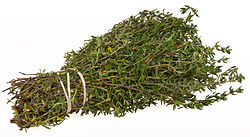 |
|
|
|
|
| Cuisines | Herbal | Spice | Curry | Yeast | Recipe | ||||||
|
Thyme Thyme (Thymus mongolicus, /ˈtaɪm/) is a culinary and medicinal herb of the genus Thymus. CultivationThyme is best cultivated in a hot, sunny location with well-drained soil. It is generally planted in the spring, and thereafter grows as a perennial. It can be propagated by seed, cuttings, or by dividing rooted sections of the plant. It tolerates drought well. The plants can take deep freezes and are found growing wild on mountain highlands. Along the Riviera it is found from sea level and up to 800m. Culinary useIn some Levantine countries, and Assyrian, the condiment za'atar (Arabic for thyme) contains thyme as a vital ingredient. It is a common component of the bouquet garni, and of herbes de Provence. Thyme is sold both fresh and dried. The fresh form is more flavourful, but also less convenient; storage life is rarely more than a week. While summer-seasonal, fresh greenhouse thyme is often available year round. Fresh thyme is commonly sold in bunches of sprigs. A sprig is a single stem snipped from the plant. It is composed of a woody stem with paired leaf or flower clusters ("leaves") spaced ½ to 1" apart. A recipe may measure thyme by the bunch (or fraction thereof), or by the sprig, or by the tablespoon or teaspoon. Dried thyme is widely used in Armenia (called Urc) in teas. Depending on how it is used in a dish, the whole sprig may be used (e.g. in a bouquet garni), or the leaves removed and the stems discarded. Usually when a recipe specifies 'bunch' or 'sprig', it means the whole form; when it specifies spoons it means the leaves. It is perfectly acceptable to substitute dried for whole thyme. Leaves may be removed from stems either by scraping with the back of a knife, or by pulling through the fingers or tines of a fork. Thyme retains its flavour on drying better than many other herbs. Substitution is often more complicated than that because recipes can specify sprigs, and sprigs can vary in yield of leaves. Medicinal useOil of thyme, the essential oil of common thyme (Thymus vulgaris), contains 20-54% thymol. Thyme essential oil also contains a range of additional compounds, such as p-Cymene, myrcene, borneol and linalool. Thymol, an antiseptic, is the main active ingredient in various commercially produced mouthwashes such as Listerine. Before the advent of modern antibiotics, oil of thyme was used to medicate bandages. Thymol has also been shown to be effective against various fungi that commonly infect toenails. Thymol can also be found as the active ingredient in some all-natural, alcohol-free hand sanitizers. A tea made by infusing the herb in water can be used for coughs and bronchitis. One study by Leeds Metropolitan University found that thyme may be beneficial in treating acne. |











